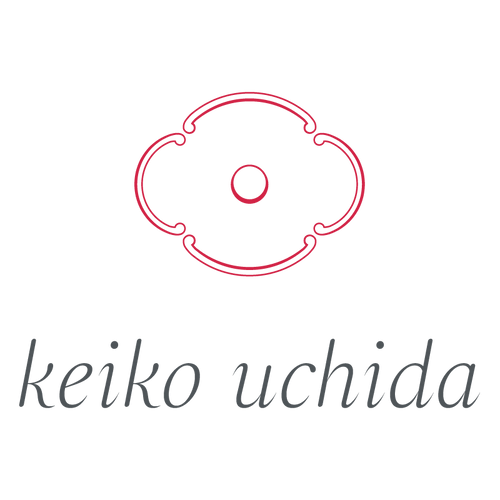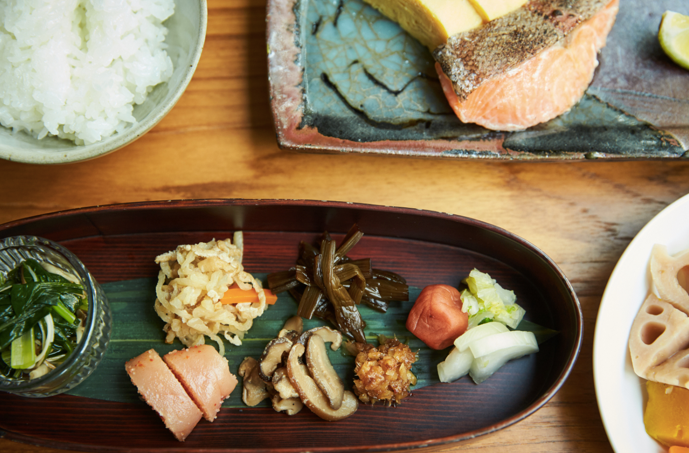As the weather is now much colder, it’s nice and warming to have a cup of tea! We have a large variety of matcha and green tea. I thought today, I’d walk you through our different green teas.
Green tea (sencha) in Japanese contains the most caffeine, as well as antioxidants compared with genmaicha, hojicha and iribancha, but less caffeine and antioxidants compared to matcha. Many Japanese people have sencha in the morning and enjoy it until around 4_00 in the afternoon. It’s nice to wake up with a cup of green tea! My family always has a traditional Japanese breakfast, like the one pictured, and green tea works well with our breakfast. I know it is very different from an English or continental breakfast, and it takes quite a lot of time to prepare! But it’s really tasty and give you lots of energy for the day. Our sencha, Shigaraki from Marukyu Koyamaen, is smooth with a strong taste, it works well with a slice of cake, as well as with breakfast and lunch.
Genmaicha is green tea with popped and roasted rice. We can taste some smokiness alongside the green tea flavour. As almost half of the tea is popped and roasted rice, it contains less caffeine than sencha. It also has a gentler taste so my parents would serve it to us when we were small. It’s perfect for a lover of green tea who wants to reduce their caffeine intake! Our genmaicha Takachiho is the very best genmaicha from Marukyu Koyamaen. It uses kabusecha (tea farmers use straw shades to protect the tea trees from strong sunshine, which produces bitterness. It’s a similar process to growing matcha tea leaves). The kabusecha means that there is a wonderful green tea flavour, as well as the roasted and smoky flavours from the rice. Lowers grades of genmaicha often use second or third harvest tea leaves, as their lesser quality taste can be masked by the popped and roasted rice. We don’t compromise on anything, as I’m obsessed with tea! I recommend using 70-75 °C water when brewing Takachiho to enjoy the delicate flavour of kabusecha.
Hojicha is a roasted green tea, which is refreshing to drink. As it doesn’t contain much caffeine, many Japanese people drink it after supper. My family always drinks it in the evening. Hojicha is becoming very trendy, and some cafes are now serving hojicha lattes. Our hojicha from Ippodo has a gentle and refreshing flavour. I feel like hojicha is good for digestion and can help us after a heavy meal. As I’m not great with caffeine, hojicha is my good friend in the evening. I also think it works very well with a slice of matcha cake and matcha ice cream!
Iribancha is the favoured tea of Kyoto locals. It was recommended to me by the Ippodo team when I visited them in Kyoto earlier in the year. This isn’t the most elegant tea – it is made from second harvest tea leaves that are smoked very heavily. The smell is almost like a bonfire! Originally people in Kyoto knew that the tea leaves that grew after the first harvest weren’t as good, but still needed to be picked to encourage growth for next year. They roasted all the second harvest leaves to create am entirely new tea! In a way it is a zero-waste tea, unique to Kyoto. I think it makes a great gift for someone living in the city, who can’t enjoy a bonfire or a fireplace, as they’ll be able to enjoy the special aroma instead! Iribancha is smoked and roasted quite heavily, so doesn’t contain much caffeine.
Most of our tea leaves are loose leaf (except iribancha) so you need a tea pot to fully enjoy them. We’ll be launching some new Kyusu (Japanese teapots) from Tokoname.
Summer is over, but we can still enjoy lovely sunshine and autumn plants in the garden. The Japanese tea master Kobori Enshu said, “We get drunk off flowers in spring, drunk off breeze in summer, drunk off moon in autumn, and drunk off snow in winter.”
I appreciate seeing a beautiful moon with my cup of hojicha in the evening, with no serious worries. I hope you all have a peaceful evening.

